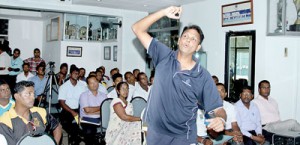More scrutiny on Senanayake before exposure
Sachithra Senanayake, the Lankan spinner in quandary, will undergo further scrutiny by Sri Lankan authorities, before he is exposed for another workout scrutiny by ICC’s biomechanical experts with regard to his clearance to play international cricket again.
Senanayake who was reported by the ICC umpiring team during Sri Lanka’s tour of England early this year was banned by the World cricket authority upon his testing at the Cardiff University, Wales.

Head of coaching Max Academy, Jerome Jayaratne enlightening the participants of the workshop about illegal bowling actions. (Picture courtesy SLC)
Thereafter, Senanayake was sent to the University of Western Australia for further scrutiny after a local team also worked on the remedial work on his bowling action.
After the remedial work, it was found out at the University of Western Australia that his action had improved very much, but, the experts there were not sure about exposing him for another ICC Test without knowing the real Testing Protocol.
Senanayake who was found flexing 39 to 44 degrees in his over-the-wicket delivery and 36 to 40 degrees while operating round the wicket at the tests that he underwent at the Cardiff University, was shown the ‘red light’ by the ICC. The world body indicated that he would not be able to operate at competitive levels. The ICC said, “It is recommended that Mr. Senanayake should not be permitted to bowl until he has undertaken remedial work to address elbow extension levels.”
However, another question at hand is that Senanayake was tested at the Cardiff University but the method of how the experts there arrived at the decision was not explained.
Reciprocally, Senanayake was sent to the University of Western Australia to be tested under Daryl Foster and at one point UWA tests say, “After remediation, in two methods (M2 & M3), the elbow extension falls under the 15 degree threshold and in the other (M1) he is above. This is why the ICC must clarify the methodology they are using to model the data. Until they do, we are flying blind with regard to how much further remediation he requires. Though I do believe we need to work on continuing to reduce his maximum flexion levels (mid-forward swing).”
However a high-ranker who is well versed on this development told the Sunday Times: “With the permission of the ICC we have afforded the chance for Senanayake to play in the ongoing Mercantile Premier League tournament.
“We can work vigorously at the lab and think that we have arrived at the right degrees of rehabilitation and now Senanayake is within the ICC stipulated count. However, we need to have some footage where he is exposed at a match situation, only then — in a real match situation — does a bowler come to his own. If you are hit for two consecutive fours he may try to retaliate.
“At the end of this tournament, we want to go back to the board to analyse his real match situations and see how he has progressed. Remember he is also under the surveillance of the umpires. They also have been asked to keep a close tab on him.”
The SLC official who wanted to remain behind the curtain, said once they go through every aspect of his rehabilitation and also after scrutinising the match situation footage they would decide if they are ready for another Test by the ICC.
After the Sunday Times’ last week exposé, the Western Australian University and the International Cricket Council are embroiled in a major row about the mechanics of the development of the Bio Mechanical Work on suspect bowling actions.
Meanwhile the Lankan authorities are having a problem with the growing numbers of bowlers, including schoolboy bowlers, with the bent arm decease.
As a result, SLC conducted a workshop for schools to create awareness. The workshop enlightened the participants on the technicalities of suspect bowling actions, educating them onthe issues faced by all parties involved with the sport. Around 60 spinners and 25 fast bowlers have been reported during this season alone.
The SLC Coaching Department is helping these reported bowlers to rectify their actions.


